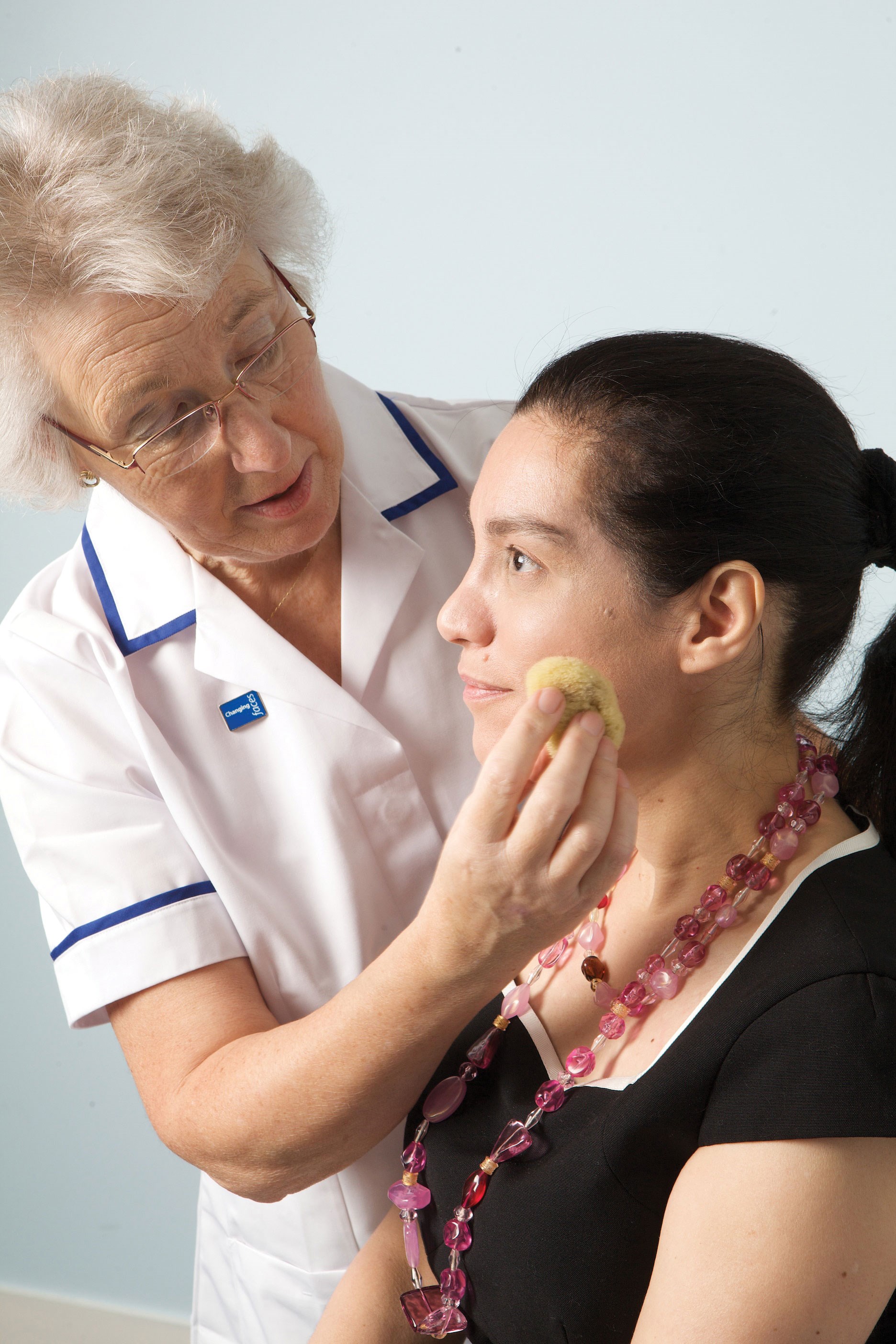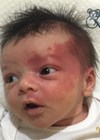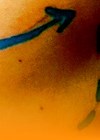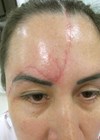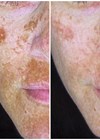Appearance matters, nowadays more than ever. We live in a global culture where a smooth, blemish-free and consistent complexion, symmetrical features and perfect teeth are highly prized and believed to be the passport to happiness and success.
If you are born with or acquire some kind of unusual-looking face, hands or body, living in such a culture can be extremely difficult. You may fear that your unusual features place you at a disadvantage and condition how you are seen by others too.
This article takes the perspective of what ‘you’ – you as a patient and the health professionals who care for you – can do to address and cope with this reality – and in particular how you might find cosmetic camouflage creams valuable. It is written for a health professional magazine but deliberately written from the perspective of ‘you’, the patient – and perhaps more importantly, of you, the citizen, and the parent or carer of a child or adolescent.
A Changing Faces skin camouflage practitioner
shows a client how to apply the creams.
(photo courtesy of Changing Faces)
Why you might look unusual
There are many reasons why you might look unusual – and in medical parlance, these are often grouped together under uncomfortable headings like ‘facial deformity’ or ‘congenital malformation’. You’d do well to avoid using those terms about your own condition or your child’s because they are stigmatising terms and there’s no need to add to your challenge. It would also be helpful if clinical teams stopped using them ‘to your face’ – even if they continue to do so in clinical or academic discussions.
The fact is that you may have been born with, or acquired during your life, a medical condition or had treatment for a condition which has left your face or body looking different to the norm and / or perhaps not moving or functioning normally either. Here’s a list of the possible reasons:
From birth:
- Birthmarks like port wine stains
- Cleft lips and / or palates
- Cranio-facial conditions and rare conditions like neurofibromatosis (Nf).
During life:
- Scarring, fractures and amputations from accidents, violence and warfare
- Cancer treatments like mastectomy or ones causing the need for facial prosthetics
- Skin conditions such as eczema, acne, vitiligo or psoriasis
- Facial paralysis after Bell’s palsy, stroke or cancer treatment
- Eye conditions including squint and loss of an eye.
So you are not alone – although you may never have met anyone with one of these other conditions – or, if you have, you may have thought them on the margins of society and never imagined that you might have an unusual face or body like them one day.
These conditions all have aesthetic effects. They make your appearance stand out from the crowd. For convenience and in order to argue for better services and fairness too, Changing Faces and other charities often refer to them collectively as ‘disfigurements’ or ‘visible or facial differences’. But as far as you are concerned you have a condition or the effects of treatment for it.
In my case, as you can see, I have the scars on my face (and hands and body) from severe burns (covering about 40% of my body) for which I was treated by many different medical professionals – primarily burns and plastic surgeons.
Interestingly, once you see that there are many different reasons for looking unusual, you’ll realise that you have some common ground with people with other conditions. You may have very different conditions but the aesthetic effects are similar. So too, you may be surprised to hear, is the emotional and social impact.
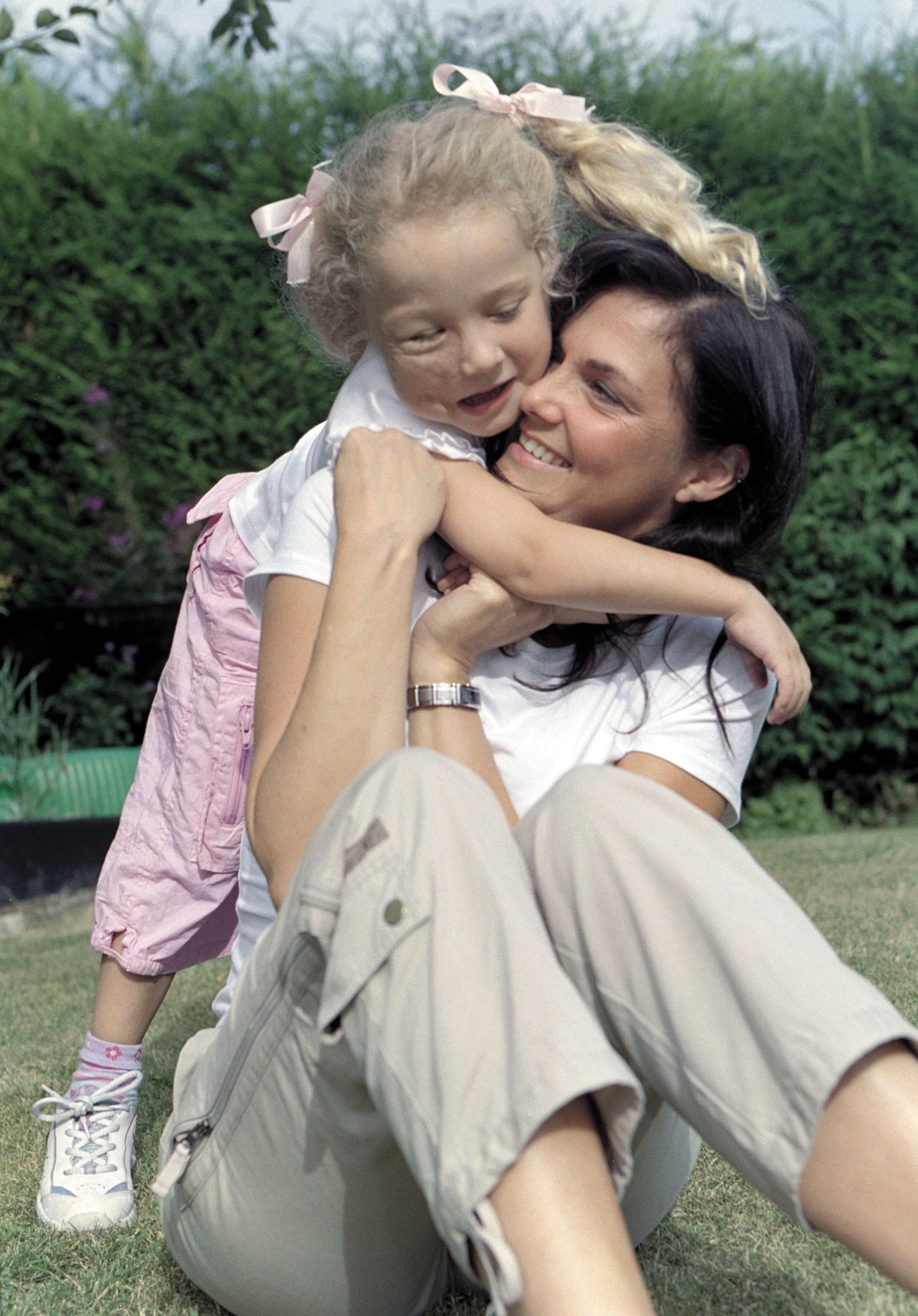
Hannah and her mother, Allison.
(photo courtesy of Changing Faces)
I recall talking to a man with a cleft lip and palate and a woman who’d had a facial cancer operation in my plastic surgery ward years ago and we came to realise that the challenges we were all going through, emotionally and in our everyday lives, were remarkably alike.
But, and this can be very frustrating, the professionals who care for you, may not realise this reality – and they may not even ask you questions about your psychological state or your social confidence (what I’ll refer to as ‘psycho-social effects’). This would be a pity and an error because once your medical treatment has been completed and you are discharged, it will be these effects that determine how well you adjust to your altered or unusual looks.
The psycho-social impact of looking unusual
Wherever you live in today’s world, you are likely to be bombarded by visual imagery of ‘good looks’ and how they make your life better. It’s an association which you may well have taken for granted, personally or as a parent. After all, there are very few successful role models or celebrities with unusual faces, facial disfigurements.
But now you have an unusual face (or body), you will have to reflect on whether you still believe good looks = success. It’s an equation which is endorsed by the corporate and celebrity world, but please note: Hollywood and Bollywood marriages don’t always survive.
And there are two other beliefs which you also need to become conscious of: first, the idea that having a scarred or unusual face is associated with being nasty, mean, evil, criminal or just plain unintelligent. That’s a rather prevalent view across the planet – a stereotype which, sadly, Hollywood continues to promote in its lazy casting of villains as in Disney’s The Lone Ranger or the portrayal of the Orcs in the blockbuster Lord of the Rings and Hobbit films. Tolkein, the author of those wonderful stories, never mentioned that the Orcs had scars at any time but it’s an easy way of marking them out as the bad guys.
Second, you may well believe that surgeons are magicians and can rebuild your missing fingers, remove the scars or reanimate your face. Reconstructive surgery, laser therapy and other modern medicine are indeed remarkable in what they can achieve today but they all have aesthetic limits. Your injury or birthmark may not be completely removable.
So what are you likely to experience, psychologically and socially, as a result of looking unusual? Three key impacts can be identified and are confirmed by research:
- Intra-personal: inside, you might feel a mixture of grief at the loss of your identity, anger, loneliness and depression. This is not surprising and is normal because your appearance has probably been important to your self-esteem and a significant part of your self-image.
- Inter-personal: you will find that everyday social encounters become very challenging and looking unusual often brings with it being stared at intrusively, avoided, asked curious questions, patronised, called names, and worse – being ridiculed or rejected.
- Medical uncertainty: you have become a patient in an unfamiliar world with a strange language and customs and you may become dependent on and grateful to particular clinicians. Understanding what’s happened to you and making decisions about potential treatments can be problematic.
You may also find it reassuring to know that these effects have been found to be common in people whatever the severity or extent of their disfigurement. What may appear to be relatively minor blemishes can have serious emotional effects especially if the scars or unusual features are in what is known as the ‘communications triangle’, from the corners of your eyes to the tip of your chin.
The good news, however, is that many people do adjust successfully to these challenges – some do so entirely by their own actions and quite quickly while others benefit from professional help. But too many people do not adjust quickly and, because they believe there is no professional help available, suffer in silence.
What can promote your successful adjustment? Research and Changing Faces’ experience over more than 20 years has established that adjustment is enhanced if people like you have or do the following:
- FINDING OUT: You find out what medicine, surgery and other treatments such as skin camouflage can offer and decide what’s right for you.
- ATTITUDE: You and your family develop positive attitudes and beliefs about the future, quashing the prevailing pessimism about your prospects if you look unusual.
- COPING: You come to terms with your feelings and that may require some outside help.
- EXCHANGING: You discover you are not alone with your condition and you may benefit from meeting others in the same boat.
- SOCIAL SKILLS: You learn the social skills to manage other people’s various reactions to your unusual appearance.
Changing Faces has developed a wide range of help to enable you to face up to these challenges. Our Changing Faces Practitioners are professionally trained and on call to provide it, under the auspices of our FACES package (see our website https://www.changingfaces.org.uk/Adults and https://www.changingfaces.org.uk/Children-and-Families). And they have produced easy-to-read self-help guides that are available online. But the important thing to realise is that no single solution is right for everyone.
Finding out about your condition and skin camouflage
Whatever your condition, it is important to learn more about it, its likely prognosis and discuss all the treatment options – and keep doing so over time so you are (more) in control and can explain it fully (if necessary) to others too.
Your clinical team may provide information but make sure that it is realistic information relevant to you. You may also use the internet but beware – website information can be very unreliable so it is worth asking your clinicians if they recommend a particular source. Which, hopefully, they have screened and decided is the best.
One type of treatment which you (or your clinical team) may not know about is the application of skin camouflage creams. Especially if you have a birthmark, scarring (including after self-harm), acne, rosacea, vitiligo, skin discoloration and other skin conditions. If your unusual feature can be concealed, you might be amazed at how effective the creams can be in giving you confidence to go into ‘dreaded’ social situations. Some people say they have got back their ‘anonymity’ or ability to blend into the crowd.
There is now a wide range of these creams on the market; in the UK, 130 of them can be prescribed by your GP. Used skilfully – and you are well advised to get expert advice on colour matching and application – they can significantly reduce the appearance of visible marks, scars and discoloration on your skin. Not only are they aesthetically effective but they provide long-lasting, waterproof cover.
In 2011-12, Changing Faces took over the unique Skin Camouflage Service from the British Red Cross, becoming the UK’s largest provider of skin camouflage advice. Other providers include private cosmetic camouflage practices and Look Good, Feel Better, a charity for women with cancer.
We have 200 trained volunteers working in 140+ NHS clinics and community settings offering one-hour appointments to around 6000 patients / clients annually who are referred to the service primarily by dermatologists, surgeons and GPs. The training is accredited by the Royal College of Nursing and the Vocational Training Charitable Trust. You can find out more by visiting https://www.changingfaces.org.uk/Skin-Camouflage
But does skin camouflage really work? Could it be for you? The evidence, although limited in scientific research terms, is convincing [1-3]. Patients are very satisfied with the advice given and say it raises their self-esteem and confidence, their self-coping skills and ability to live independently. Seeing their patients’ experience, health professionals believe it reduces patients’ future demands on GPs and other services (e.g. mental health). So what’s good for the NHS may be good for you too:
“The best aspects were giving me camouflage products available on prescription to cover my scar, the ease of applying the products and the fantastic effect it has. People look at me now when they talk to me, not my scar. Excellent.”
As for any treatment, the risks and benefits need to be weighed up. Camouflage can become a crutch. Some wear it all day every day. But if used carefully and judiciously, it can be liberating.
References
1. Saul K, Thistlethwaite JE. A patient’s journey: Facial disfigurement. BMJ 2011;343:d5203.
2. McMichael L. Practice Pointer: Skin Camouflage. BMJ 2012;344:d7921.
3. Holme SA, Beattie PE, Fleming CJ. Epidemiology and Health Services Research: Cosmetic camouflage advice improves quality of life. British Journal of Dermatology 2002;147:946-9.
Further reading
Changing Faces. Face Equality for Patients with Disfiguring Conditions: How health and social care professionals can support and empower. 2009. Accessed from
https://www.changingfaces.org.uk/
Health-Care-Professionals/
Publications/For-health-professional
Kent G. Testing a model of disfigurement: effects of a skin camouflage service on well-being and appearance anxiety. Psychology and Health 2002;17(3):377-86.
Khanche S. Changing Faces: Exploring the use of Skin Camouflage, Dermatological Nursing 2012;11(4):44-7.
Lansdown R, Rumsey N, Bradbury E, et al. (Eds.). Visibly different: Coping with disfigurement. Oxford, UK: Butterworth-Heinemann; 1997.
Partridge J. Changing Faces: the Challenge of Facial Disfigurement. London, UK: Penguin and Changing Faces; 1990 and 2012.
Rumsey N, Harcourt D (Eds). The Oxford Handbook of the Psychology of Appearance. Oxford, UK: OUP; 2012.
Declaration of competing interests: None declared.
TAKE HOME MESSAGE
-
There are many causes of ‘disfigurement’ from birth and during life.
-
The aesthetic effects are similar – and so are the psychosocial effects.
-
Clinical teams need to recognise, assess and address these.
-
Changing Faces offers emotional and practical help through its practitioners and online.
-
Skin camouflage creams can be very effective in giving people confidence.
COMMENTS ARE WELCOME

